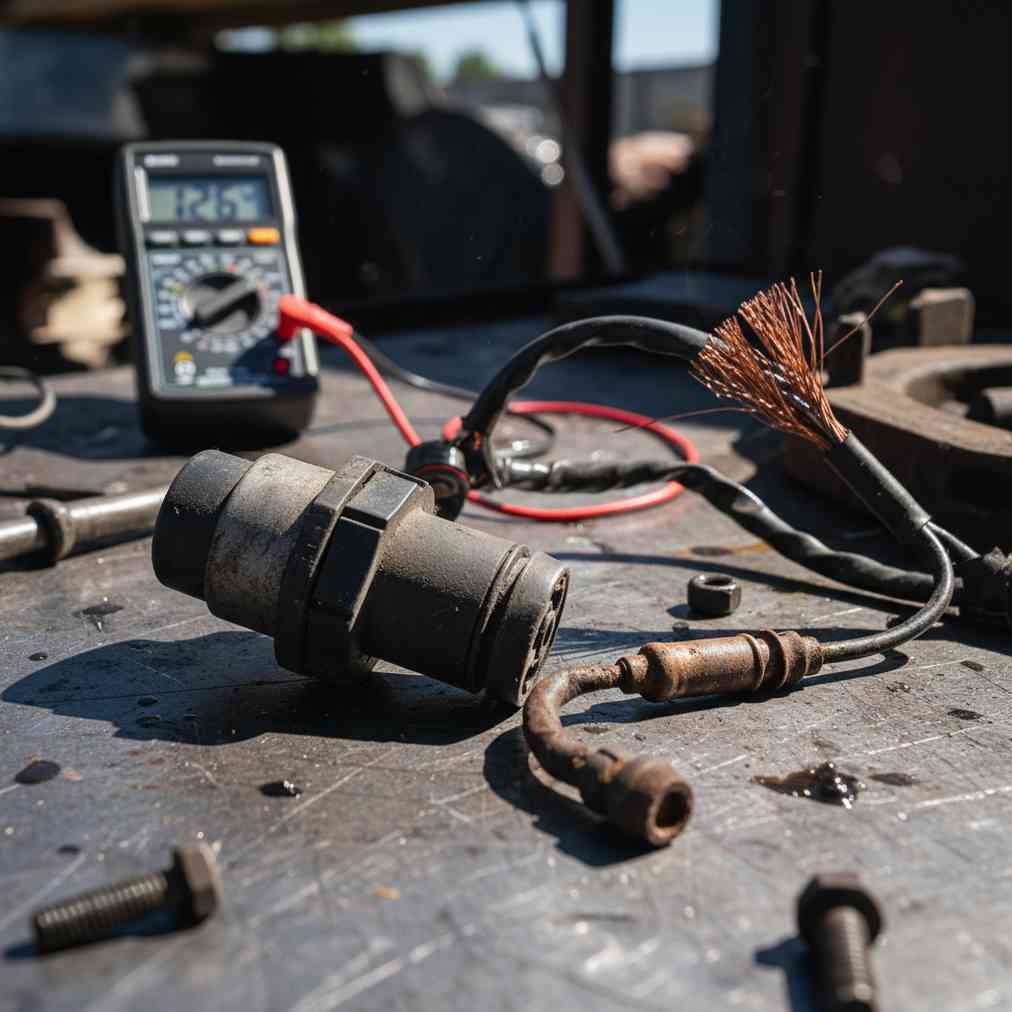Why Buy Used Sensors from Salvage Yards?
Engine sensors like O2 (oxygen), MAF (mass air flow), and MAP (manifold absolute pressure) sensors are critical components that directly impact your vehicle’s fuel economy, emissions, and performance. When these sensors fail, replacement costs can be substantial, making salvage yards an attractive alternative for budget-conscious car owners.
Buying used sensors from junkyards near me offers several compelling advantages over purchasing new parts. The most significant benefit is the cost savings of 50-70% compared to new OEM or aftermarket sensors. Additionally, used OEM sensors maintain their original factory calibration and compatibility, often providing superior performance compared to cheaper aftermarket alternatives.
- Cost Efficiency: Save 50-70% on sensor replacement costs
- OEM Quality: Original equipment maintains factory specifications
- Environmental Impact: Reduce waste through parts reuse
- Immediate Availability: No waiting for back-ordered parts
- Warranty Options: Many reputable yards offer 6-month warranties
Essential Visual Inspection Before Testing
Before conducting any electrical tests, a thorough visual inspection is your first line of defense against purchasing faulty sensors. This critical step can save you time and money by identifying obvious defects that would render the sensor unusable.
| Inspection Area | What to Check | Red Flags |
|---|---|---|
| Electrical Connector | Pin condition, housing integrity | Bent pins, cracks, corrosion, burn marks |
| Sensor Housing | Physical damage, contamination | Cracks, oil contamination, impact damage |
| Wiring Harness | Wire condition, insulation | Frayed wires, exposed copper, heat damage |
| Mounting Points | Threads, brackets, seals | Stripped threads, broken mounting ears |
Pay special attention to heat damage indicators such as discolored plastic housings or melted wire insulation, as these sensors operate in high-temperature environments. For MAF sensors, inspect the delicate sensing element for oil contamination or physical damage that could affect airflow readings.
Testing O2 Sensors at the Yard
Oxygen sensors are among the most commonly replaced engine sensors, making them frequent salvage yard finds. These sensors measure exhaust gas oxygen content to help the ECM maintain optimal air-fuel ratios. Testing O2 sensors requires understanding their operating principles and voltage characteristics.
O2 Sensor Types and Characteristics
- Zirconia Sensors: Output 0.1V-0.9V based on oxygen content
- Heated Sensors: Include internal heater for faster operation
- Wideband Sensors: Provide linear output across broader range
- Narrow Band Sensors: Switch between rich/lean readings
Most standard O2 sensors have 3-4 wires: signal output, ground, and heater circuit (positive and negative). The heater circuit resistance test is often the most practical field test, as it doesn’t require the sensor to be heated to operating temperature.
Multimeter Testing Procedure
Using a digital multimeter, set it to measure resistance (ohms) and test the heater circuit continuity. Most O2 sensor heaters show 4-14 ohms resistance when functional. A reading of infinite resistance indicates a burned-out heater element, while zero resistance suggests a short circuit.
For voltage testing, connect the positive probe to the signal wire and negative to ground. When heated to operating temperature, a functional sensor should fluctuate rapidly between approximately 0.1V and 0.9V, indicating proper rich/lean detection capability.
MAF Sensor Testing and Evaluation
Mass Air Flow sensors measure the amount of air entering the engine, providing critical data for fuel injection calculations. Faulty MAF sensors can cause poor idle, stalling, or reduced fuel economy, making proper testing essential before purchase.
Testing engine sensors like MAF units requires understanding their voltage or frequency output characteristics. Most MAF sensors output either analog voltage (0.5V-5V) or digital frequency signals proportional to airflow volume.
MAF Sensor Testing Methods
| Test Type | Equipment Needed | Procedure | Expected Results |
|---|---|---|---|
| Voltage Output | Digital multimeter | Measure signal wire voltage at rest and with airflow | 0.5-1.0V at rest, increasing with airflow |
| Power Supply | Multimeter, 12V source | Check power and ground circuits | 12V or 5V reference voltage present |
| Frequency Output | Frequency meter | Measure Hz output with airflow changes | Frequency increases with airflow |
| Resistance Check | Ohmmeter | Check internal resistance values | Within manufacturer specifications |
When testing MAF sensors, simulate airflow by gently blowing air across the sensing element while monitoring voltage output. A functional sensor should show smooth voltage increases proportional to airflow changes. Erratic readings or no voltage change indicate sensor failure.
MAP Sensor Testing Techniques
Manifold Absolute Pressure sensors measure intake manifold vacuum and pressure to help calculate engine load. These sensors typically output 1-4.5 volts corresponding to various vacuum/pressure conditions, making them relatively straightforward to test with basic equipment.
On-Car Testing Without Tools
A simple field test involves disconnecting the MAP sensor while the engine is running. If the sensor is functional, the engine should stall immediately as the ECM loses critical load calculation data. If the engine continues running normally, the sensor may already be failed, and the ECM is using default values.
Important Note: This test should only be performed briefly and with caution, as running an engine with disconnected sensors can potentially cause damage or trigger diagnostic codes.
Vacuum Pump Testing Method
For bench testing, use a handheld vacuum pump connected to the MAP sensor’s vacuum port. With a multimeter measuring the signal output, apply varying vacuum levels while monitoring voltage changes. A properly functioning MAP sensor should show smooth, linear voltage changes corresponding to vacuum variations.
- Atmospheric Pressure: ~4.5V output (no vacuum)
- Moderate Vacuum: ~2.5V output (10-15 inHg)
- High Vacuum: ~1.0V output (20+ inHg)
Using OBD-II Scan Tools for Sensor Verification
Modern OBD-II scan tools provide the most comprehensive method for testing used sensors, offering real-time data display and diagnostic trouble code reading. Even basic scan tools costing $30-50 can reveal valuable sensor information when testing at salvage yards.
Testing car sensors with diagnostic tools allows you to observe actual sensor performance under various operating conditions, providing more accurate assessment than static voltage measurements alone.
Scan Tool Testing Procedures
| Sensor Type | Test Condition | Expected Response | Failure Indicators |
|---|---|---|---|
| O2 Sensor | Engine at 2500 RPM | Rapid 0.1V-0.9V oscillation | Flat line, slow response, stuck readings |
| MAF Sensor | Varying RPM | Smooth gram/second increases | Erratic readings, no change with RPM |
| MAP Sensor | Throttle variations | Voltage changes with manifold pressure | Fixed voltage, inverse readings |
When using scan tools, look for smooth, predictable sensor responses to changing conditions. Sensors that show erratic readings, stick at fixed values, or respond inversely to input changes should be avoided.
Practical Salvage Yard Testing Checklist
Having a systematic approach ensures you don’t miss critical evaluation steps when examining used sensors. This comprehensive checklist covers all essential testing procedures you can perform at most salvage yards.
| Step | Component | Test Method | Pass Criteria |
|---|---|---|---|
| 1 | All Sensors | Visual connector inspection | Clean pins, intact housing |
| 2 | MAF Sensor | Internal element check | Clean, undamaged sensing wire |
| 3 | MAP Sensor | Vacuum line inspection | Pliable hose, clear port |
| 4 | All Sensors | Donor vehicle assessment | Low mileage, good condition |
| 5 | O2 Sensor | Heater circuit resistance | 4-14 ohms typical range |
| 6 | MAP Sensor | Voltage response to vacuum | Linear voltage changes |
| 7 | MAF Sensor | Airflow response test | Voltage increases with airflow |
| 8 | All Sensors | Warranty verification | 30-day minimum return policy |
Common Testing Mistakes to Avoid
Even experienced buyers can make costly mistakes when evaluating used sensors. Understanding these common pitfalls helps ensure you make informed purchasing decisions and avoid problematic components.
- Skipping Visual Inspection: Rushing to electrical tests without checking for obvious physical damage
- Wrong Test Parameters: Using incorrect voltage ranges or resistance values for specific sensor types
- Ignoring Donor Vehicle History: Not considering if the vehicle was flood-damaged or poorly maintained
- Inadequate Testing Equipment: Using cheap or uncalibrated multimeters that give false readings
- Temperature Considerations: Testing sensors without accounting for operating temperature requirements
Remember that some sensors, particularly O2 sensors, require specific operating temperatures to function properly. Cold testing may not reveal intermittent failures that occur only when the sensor reaches normal operating temperature.
Understanding Salvage Yard Warranties and Return Policies
Reputable salvage yards understand that electronic components like sensors can fail unexpectedly, even after passing initial tests. Most established yards offer warranty periods ranging from 30 days to 6 months on electronic components, providing valuable protection for your investment.
Before purchasing any used sensor, clarify the yard’s specific warranty terms and return procedures. Some yards may offer cash for cars programs but have different policies for parts purchases.
Key Warranty Questions to Ask
- Warranty Duration: How long is coverage provided?
- Return Requirements: What condition must parts be in for returns?
- Installation Requirements: Must professional installation be required?
- Diagnostic Requirements: What proof of failure is needed?
- Exchange vs Refund: Can you get money back or only exchanges?
Tools and Equipment for Sensor Testing
Effective sensor testing requires having the right tools available. While salvage yards may have basic testing equipment, bringing your own ensures you can perform thorough evaluations on any sensors you’re considering.
| Tool | Purpose | Typical Cost | Priority Level |
|---|---|---|---|
| Digital Multimeter | Voltage, resistance, continuity testing | $20-100 | Essential |
| OBD-II Scanner | Live data, diagnostic codes | $30-200 | Highly Recommended |
| Handheld Vacuum Pump | MAP sensor pressure testing | $25-50 | Recommended |
| Back-probe Kit | Non-invasive wire testing | $10-25 | Useful |
| Flashlight/Headlamp | Visual inspection in dark areas | $10-30 | Essential |
Invest in quality testing equipment, as accurate measurements are crucial for proper sensor evaluation. A good digital multimeter with auto-ranging capabilities and a basic OBD-II scanner will handle most sensor testing requirements you’ll encounter at salvage yards.
Safety Considerations When Testing Sensors
Testing automotive sensors involves working around electrical systems, running engines, and potentially hazardous materials. Following proper safety procedures protects both you and the equipment you’re testing.
- Electrical Safety: Ensure proper grounding and avoid short circuits
- Engine Safety: Never leave engines running unattended during testing
- Chemical Safety: Some sensors may have residual fuel or oil contamination
- Eye Protection: Wear safety glasses when working around vehicles
- Tool Safety: Use insulated tools when working with electrical components
When testing sensors on running vehicles, be extremely cautious around moving parts, hot surfaces, and electrical connections. Many salvage yards have specific safety requirements that must be followed during testing procedures.
Cost-Benefit Analysis: New vs Used Sensors
Understanding the true cost difference between new and used sensors helps justify the time investment required for proper testing and evaluation. The savings potential often makes the extra effort worthwhile for most repair situations.
| Sensor Type | New OEM Price | New Aftermarket Price | Used Price Range | Potential Savings |
|---|---|---|---|---|
| O2 Sensor | $150-300 | $50-150 | $20-75 | 60-80% |
| MAF Sensor | $200-500 | $75-250 | $30-125 | 50-75% |
| MAP Sensor | $100-250 | $35-100 | $15-60 | 65-85% |
The substantial savings potential makes the investment in testing equipment and time highly worthwhile. Even accounting for occasional sensor failures, the overall cost savings typically exceed 50% compared to new parts purchases.
Environmental Benefits of Buying Used Sensors
Beyond cost savings, purchasing used sensors provides significant environmental benefits through resource conservation and waste reduction. The automotive industry has increasingly recognized the importance of parts recycling in reducing environmental impact.
- Resource Conservation: Reduces raw material extraction for new sensor manufacturing
- Energy Savings: Eliminates energy-intensive manufacturing processes
- Waste Reduction: Prevents functional components from entering landfills
- Carbon Footprint: Reduces transportation and packaging requirements
- Circular Economy: Supports sustainable automotive repair practices
Each reused sensor represents avoided manufacturing emissions and resource consumption, contributing to more sustainable automotive repair practices while providing economic benefits to vehicle owners.
Final Recommendations for Sensor Testing Success
Successfully purchasing used sensors from salvage yards requires combining thorough inspection techniques with proper testing procedures and realistic expectations. Following systematic evaluation processes significantly increases your chances of finding reliable, cost-effective sensor replacements.
Remember that even with careful testing, electronic components can fail unexpectedly. Choose salvage yards with good reputations and reasonable warranty policies to protect your investment. The time spent on proper evaluation pays dividends in reduced repair costs and reliable vehicle operation.
Expert Tip: Keep detailed records of your sensor testing results and purchase information. This documentation proves valuable if warranty claims become necessary or if you need to reference successful testing procedures for future purchases.
With proper knowledge, appropriate tools, and systematic testing approaches, buying used sensors from salvage yards offers an excellent opportunity to maintain your vehicle reliably while achieving substantial cost savings. The combination of economic and environmental benefits makes this approach increasingly attractive for informed automotive enthusiasts and professional repair shops alike.





Leave a Reply
You must be logged in to post a comment.